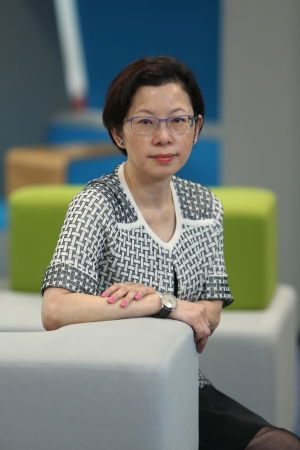share on
From creating employee resource groups to help bring forward diverse perspectives to using bias interrupters during the interview process, with consistent assessment criteria, here's what our leaders have to say.
The long-awaited second edition of HR's guide to starting your DEI journey is finally here! In this special final part, 21 leaders share brilliant advice with Arina Sofiah for you to start on your DEI journey.
These tips, suggestions, and ideas range across diverse sectors - from building the talent pipeline and attracting diverse talent, to assessing current policies accommodate people of diverse backgrounds, here's what our leaders have to say.
Raquel Patdu, Head of Finance and Business Services, Jebsen & Jessen Ingredients Philippines (JJIP)

Organisations that actively prioritise DEI will gain a competitive advantage as they have the opportunity to tap on a wider pool of talent. DEI should be made a priority to celebrate and leverage each other’s differences, and build a well-rounded and future-ready culture. With a strong focus on DEI, organisations will benefit from it at every level of the business, as employees become more engaged and happy as they develop a sense of value to the company.
It is also important for business leaders to be strong advocates of DEI programmes, and include DEI in their corporate values and company DNA. A good place to start would be for leaders to be aware of their personal biases – set them aside and look at people for who they really are and what they can bring to your organisation regardless of their background.
Ekta Makhija, Research Scientist at Critical Analytics for Manufacturing Personalised-Medicine (CAMP), Inter-Disciplinary Research Group (IRG), Singapore MIT Alliance for Research and Technology (SMART), MIT’s research enterprise in Singapore

Having a diverse workplace allows organisations to draw from a larger pool of new talent and also helps to retain existing talent. When people from different backgrounds work together, they tend to find role model qualities in each other. Having worked in three different organisations since 2009, including SMART, I have seen senior female postdoctoral researchers and professors juggle both motherhood and their careers. They were my guiding beacons as I embarked on my motherhood journey years later.
To prioritise DEI, organisations should assess whether their current policies accommodate people of diverse backgrounds. Organisations should stop the assumption that the performance of female employees is impaired by marriage and childbearing. Most female employees who receive support in the form of adequate maternity leave, childcare benefits and flexible working hours become more loyal and committed towards the very organisation that supported their family during the challenging transition period.
There is an increasing awareness of a skewed gender ratio in the STEM sector. Organisations are becoming more accommodating of maternity (and paternity) leave and flexible working hours. In the last decade, numerous organisations that support women in STEM have been established to highlight the many struggles that women in the industry face and overcome them.
The biggest challenge for many working mothers, including myself, is the internal struggle and guilt brought on by juggling her STEM passion, career obligations, and her maternal biological instinct of caring for her child. My advice to women aspiring to balance their career and motherhood is to build a support system of alternate caregivers and let go of their need to be perfect mothers.
Dr Shirley Knowles, Chief Inclusion and Diversity Officer, Progress

An organisation is putting itself at a disadvantage if it’s not prioritising diversity, equity, inclusion, and belonging with a global workforce. Even before the pandemic, people were looking for and joining companies that understood their diverse employee and customer populations – to not see the benefit in these diverse backgrounds and perspectives, and how they can positively impact your product line and your bottom line, is putting a company in a position to financially lose to their competitors who do understand the importance of DEIB.
If a company doesn’t know where to get started in their DEIB journey, they can bring in a consultant to do a quick analysis of the easy wins they can achieve within their organisation. Should the company be recruiting more diverse candidates for open leadership roles? Should the organisation create some employee resource groups to help bring forward diverse perspectives? Are there mentorship programmes in place that could help amplify the work of top talent that are from underrepresented groups? What positions are disabled, veteran, women, or people of color occupying – are they primarily individual contributors and not in leadership roles? These type of questions push companies to slow down and really evaluate the work that can be done around DEIB.
This doesn’t apply to all organisations, but there are some that think DEIB is something that can be solved in a year or so and then they’re done. That is not the case – this type of work is like a marathon. You have to be in it for the long haul. There aren’t quotas to meet and you can’t just make your next three hires all women and then you’re done. If someone is looking to do this work in a very meaningful way, they have to look at how they can make a difference in the way the company hires, develops, and promotes underrepresented groups from now on.
Tsu-Shien Teoh, President. Henkel Malaysia

At Henkel, we have seen that having an inclusive culture that values diversity fosters trust and collaboration and lead to greater exchange of ideas and innovation. As a first step, top management must demonstrate their commitment, for example in their corporate value statement and setting measurable milestones. In parallel, it is important to engage employees through dialogue and training sessions on DEI topics, such as dealing with unconscious bias, to create awareness and change mindset. One thing to stop doing is to make decisions based on assumptions of, for example, gender, ethnicity, disability and generations. At Henkel, we are committed to fostering a culture of belonging and strive for equity to realise the full potential of our diversity.
Akshita Shetty, Vice President, Human Resources, SAP South East Asia

In the wake of changing demographics of the talent landscape and the pandemic situation, we have seen that employees today have a renewed sense of awareness at work and are expecting organisations to focus on purpose which is strongly linked to diversity, equity, and inclusion (DEI). Prospective employees believe DEI should be an integral part of an organisation and hence it has become more important now than ever to prioritise DEI.
Having a diverse workforce and inclusive culture where employees feel they can bring their best selves to work each day not only increases employee engagement and customer satisfaction, but also fuel an organisation’s ability to innovate. If this is not a priority for an organisation, they will lose the mindshare of attracting the right talent, drive meaningful impact and ultimately increase the bottom line of an organisation.
My personal philosophy is this – If companies are unsure about starting big, start small. Set smaller DEI goals, create pilots for small initiatives that will help move the needle. One thing that companies can start doing is to use bias interrupters. Research shows that bias in the process can be interrupted by giving managers structured form to use, with objectives and consistent criteria for evaluation and concrete evidence to justify the rationale.
At SAP, we use bias interrupters during the interview process, with consistent assessment criteria, questions, and a diverse interview panel. This helps with the consistency in the process, reduces bias and if there is a disagreement, provides clear evidence for justification based on facts.
While most companies are focused on outcome metrics, we lose sight of process metrics. Process metric is very crucial to ensure the means to get to the outcome is aligned with the objective to get the outcome. For example, some of the job descriptions published are stereotypical and biased, with the description aiming towards a section of the population. If we want to attract a diverse application pool, then the job descriptions need to be bias free, with neutral language which caters to all sections of the talent pool.
Sarah Dunn, Head of Employee Experience, Adobe Asia Pacific

Investing in DEI is no longer an ideal concept but an imperative. While it is vital to foster a conducive environment that supports DEI, it is equally important that organisations show a tangible commitment and implement concrete measures to drive actions. At Adobe, we introduced 'Adobe for All in Action' – five simple steps to build a diverse and inclusive workplace for all, and are constantly pushing the envelope to support women in the workforce. In 2018, Adobe achieved gender pay parity and are now focusing on 'opportunity parity'. Our Women’s Executive Shadow Programme, Leadership Circles and more, have enabled us to make strong advancements towards equality.
Organisations should stop looking at addressing DEI with a stop-gap approach and implement a holistic strategy – from building talent pipeline, attracting diverse candidates, enhancing employee experience, to driving diversity across the industry. When people feel appreciated and included, they are more creative, innovative and successful.
Aditi Kohli, Senior Vice President APAC, GWI

While there’s been more conversation around the importance of DEI over the last few years, it isn’t enough - the kind of change that’s needed can’t happen overnight, but it should be a priority for every organisation. No business is the exception to the rule. Organisations should make commitments and turn these commitments into action with positive and measurable outcomes. It might be tempting to opt for quick wins, but it’s crucial to plan for the mid and long-term, track progress, check in, and hold people accountable. It requires investment - and it’s one of the most important and necessary investments an organisation can make. It should be an essential cost to a business, as unavoidable as paying wages.
Antoinette S. Gutierrez, Country Head – OMRON Management Center for Asia Pacific (The Philippines Branch)

Diversity, equity and inclusion is a topic of increasing importance for many organisations. For companies who are yet to prioritise it, I would strongly recommend them to consider embracing these initiatives in their business. Having a diverse workplace has immense benefits that can give an organisation a competitive edge as well as bring in eclectic and wider range of ideas, skills and resources These initiatives also promote teamwork, collaboration, loyalty and retention.
Organisations can get started by first researching about industry best practices - gauging the DEI initiatives of other organisations not only in terms of results they’ve achieved but also the time taken to see those results. Second, I suggest that they must ensure that all employees within the organisation are engaged and fully bought in. Third, reporting on the efforts is vital to change the course of actions, if need be and evaluate the impact.
The things that need to be stopped immediately are exclusion, discrimination, and bias. The effect of these can be devastating for an organisation as it impacts its members’ happiness, confidence, and in turn productivity of the entire organisation.
Clare Muhiudeen, Head of Asia, WTW

Diversity, equity, and inclusion (DEI) is an asset to any organisation that commits to it. A recent survey by WTW found that 43% of employers across Asia Pacific said an emphasis on DEI has been a key pressure point in the past three years. Business leaders are beginning to realise that significant value exists in creating an environment where all employees can flourish.
A good first step when trying to decide what to prioritise and when to start is to have a dedicated leader for the DEI agendas as clear ownership is necessary for intentional execution of DEI. To get things into motion, data and insights on gender, seniority, roles, pay levels, and promotion, as well as listening to employees through surveys or focus groups, could be used to understand which part of the DEI agendas to prioritise.
Organisations need to be honest and take a critical look at their existing internal processes for improving the implementation of their DEI agendas. For instance, interview panels that do not represent diversity in gender, function, or background are not going to make progress in hiring or promoting a more diverse workforce of the future.
Dr. Betty Vandenbosch, Chief Content Officer, Coursera

Progress isn’t a solitary journey. Growing the participation of women workers is critical to unlock sustained economic benefits, including an increase in annual GDP. Organisations must leverage the opportunities created by remote work and online learning to make meaningful changes and empower more women to benefit from the promise of a digital future. Governments, businesses, and higher education institutions must collaborate to equip women with the critical skills needed to enter or re-enter the workforce in high-demand fields and promote economic mobility. Placing a greater focus on offering flexible and affordable pathways through entry-level professional certificates is an ideal way to diversify hiring and increase workplace equity.
Alice Ting, Country Managing Director of Hong Kong, Telstra

It is important to embrace diversity so that we can include and understand all voices within an organisation. This is a conscious decision, and one that organisations must embed within their culture, guidelines, and policies.
One thing an organisation should try to eliminate from its culture is unconscious bias. This can impact diversity, recruiting, and retention efforts, as well as create unfair outcomes. Therefore, companies should foster an equal opportunity culture at work.
At Telstra, we have committed to improving gender equality by requiring at least 50% female representation on recruitment and interview shortlists. Gender equality is not a box-ticking exercise, it is a core part of our corporate values and should frame how an organisation makes decisions.
We are constantly developing new ways to create an inclusive and supportive environment. For example, our Brilliantly Connected Women programme brings women within the business together to share ideas and offers tools to help them succeed.
Kelly Chan, Area Vice President, Metallic Sales, APJ, Commvault

Embracing DEI is key to the success of any organisation today. Diversity in the workplace not only promotes employee engagement, arouses the curiosity to learn, but breeds innovation by incubating the varying perspectives from the equitable participation of all employees. Equity is also integral to fair treatment and opportunities, the cornerstone for trust and teamwork.
For instance, at Commvault, we strive to cultivate and maintain an intentional, equitable, and inclusive workplace community that rallies employees closer together despite the different backgrounds and experiences that we bring to our roles.
To get started, leaders must understand that DEI today is more than running a programme but a business imperative for any best-in-class organisation. They need to commit to and uphold DEI policies and not come across as just paying lip service. Additionally, leaders must ensure that DEI initiatives are scalable and sustainable in accordance with growth and long-term plans for their organisations.
Pauline Ho, PwC Asia Pacific Human Capital Leader & 30% Club Steering Committee member

In PwC’s Hopes and Fears Survey 2021, we found that having an organisational purpose and aligning business practices with this purpose is essential. After all, Malaysian employees view organisations that contribute positively to society favourably.
Having a DEI strategy is a good starting point to attract and retain talents, to which four key elements are essential:
- Understanding what's happening in the organisation - this includes metrics like performance and compensation data and customer feedback as a foundation to craft your strategy.
- Building an inspirational strategy - Using the data gathered to create a business focused vision and strategy for DEI. Identify your focus areas e.g. gender, generational, ethnicity and/or abilities.
- Leadership engagement - Engaging leadership on your strategy, supported by a clear business case, governance and policies.
- Creating sustainable movement - Executing the DEI strategy across all elements of the talent lifecycle.
Organisations that can translate their DEI strategy into actions can look forward to long-term gains.
Arno Kamm, General Manager, Roche Services & Solutions APAC

Creating a diverse & inclusive culture without a doubt is the right thing to do for any organisation seeking to hire, retain, and engage a diverse talent pool. Many organisations, big and small, have proven that with inclusive workplaces, they see better business results. This is because, when an organisation truly invests in the process, inclusion unlocks the employee's potential and spurs innovation. At the same time, it can feel like a challenging task, especially for small or resource-tight companies to embark on a diversity & inclusion journey. My advice is to start small. You can even make a meeting more inclusive by putting practices in place that encourage introverts to speak up to demonstrate your commitment to DE&I. These best practices can all go a long way toward your employees feeling “heard” and “engaged” in the workplace.
To get started on this journey, it is important to be transparent about what works well or otherwise in an organisation. A great place to start would be a survey to gauge employee sentiment and feedback to determine a baseline of D&I and areas of improvement. This will help the organisation define and prioritise some initial goals and action plans and develop a long-term strategic plan that provides training for leadership and teams to begin their D&I journey.
Stop treating diversity & inclusion as a side project. For D&I to truly work, you will need to give the same amount of priority and commitment that you give the rest of your business areas.
Sim Gim Guan, Executive Director, Singapore National Employers Federation (SNEF)

The Singapore resident workforce is diverse with workers of different ages; genders; nationalities; race, and religion. Employers who do not have a diverse workforce have not leveraged on the diversity that is present in our workforce, and would have limited themselves to a smaller pool of talent.
My advice for organisations is that they should capitalise on DE&I to harness the full potential of a diverse workforce. By managing DE&I better, employers can strengthen workplace relations, collaboration, and innovation. The first thing that employers can do is to be fair in their employment practices, starting with recruitment. If they have unfair employment practices, they should take immediate corrective steps to ensure workplace fairness.
Beyond workplace fairness, employers should make workplaces more inclusive. Employers can also tap on the OneWorkplace.sg initiative, managed by SNEF, to foster workplace integration.
Nathalie Huynh, Cluster HR Director, Singapore, Malaysia, Brunei at Schneider Electric

Research shows that organisations that embrace DEI are more likely to significantly and positively impact their brand reputation, people engagement, innovation and performance.
Implementing DEI starts by defining the ambition. DEI can be challenging because it highlights individuals' unique values and differences while at the same time, harness this diversity. To achieve this, DEI must be anchored in inclusive practices, policies, and behaviours.
At Schneider Electric, we are committed to offering equal opportunities and creating a culture where every employee feels valued, safe and empowered to contribute their best. This is grounded in our core value, "embrace different", and guided by our framework to promote gender equity and workplace diversity.
Organisations can also start by raising awareness on bias - including topics such as gender and generational gaps, cultural differences, and diversity of backgrounds - to create a safe environment for dialogue and actions that enable them to leverage DEI as a strategic asset as part of their sustainability goals.
Richa Gupta, Chief People Officer, Globalization Partners (GP)

As a proud immigrant who was raised in a small city with limited resources and who came to the United States from India with just $4,000, a suitcase and a big dream, International Women’s Day has a very personal meaning to me. Today, I’m CHRO for a global employment platform that makes it easy to hire anyone, anywhere, no matter where they reside. I’ve witnessed how the acceptance of hiring talent remotely has been particularly and positively impactful for women. With newfound access to jobs, women do not have to leave the workforce in the significant numbers they did due to the pandemic thus sacrificing their professional and financial wellbeing; families, and even communities, can stay intact.
International Women’s Day is also a great time to remember the importance of how all employees feel about their workplace – most notably, in relation to feelings of inclusion, fulfilment, happiness and trust in leadership. It is my core belief that from recruitment, to development, to establishing inclusive policies, all businesses must strive to prioritise inclusion across every aspect of the organisation to further accelerate progression. It’s so important to be conscious of what a balanced and inclusive team looks like, to integrate people from all walks of life with empathy and to be cognisant of what it takes to achieve this.
We all know we have a long way to go towards equality for women worldwide, but I do believe that as the world of work continues to change and adapt to more remote work and autonomy, women (and all genders) will find that geography no longer dictates their destiny. I believe that if you include and offer chances to women in a variety of roles and fields globally, you automatically ensure global inclusivity and as a result, will #BreakTheBias on International Women’s Day and beyond.
At GP, we believe that our culture of inclusion starts with the power of the purpose of our company; it is co-created by our 'dream team' for care, community and belonging; further nurtured by our leaders with empathy, empowerment, and trust; strengthened by listening and educating our teams; and supported by inclusive hiring and talent practices. We believe that if you chase inclusion, diversity follows. I’m proud that our gender ratio is almost even with 47% women to 53% men in our entirely remote, global team of over 900 employees (and growing!) worldwide. Together we must champion and celebrate the successes of women around the world who are achieving great things. Though we still have a long way to go in creating a more equal and just world, together is the only way we will get there. My advice for other women is to keep learning, keep networking, hone your skills and most importantly, trust yourself and your superpowers (yes, you have many!).
Megan Barbier, Vice President, People & Culture, Jumio

While International Women’s Day is a day to celebrate women’s accomplishments, we also must stop to remind ourselves of the importance of getting more women recruited into the technology industry by creating an inclusive workplace. All too often, businesses see creating a positive and inclusive workplace environment as an afterthought, and though companies are making great strides in shifting away from this attitude, they can always do more.
For organisations within the technology sector, improving female representation must become a priority that is actively pursued rather than just a token gesture. The process of shifting the gender balance to include more women can seem overwhelming. Move the needle by weaving diversity into all aspects of the employee experience: talent acquisition, development and recognition. Providing equitable access to training, projects and other resources, coupled with structured guidance on their professional development, businesses can better support the advancement of women in technical roles.
Businesses must also reflect on and acknowledge the importance of promoting diversity and inclusion across every aspect of their organisation. Diversity and inclusion are key in driving business innovation and creativity. To help women thrive in professional technology environments, leverage the power of both ERGs (employee resource groups) and male colleagues to build a strong community and promote ally-ship. By creating a diverse and inclusive workforce, organisations can tap into a wide range of perspectives and unique ideas, whilst unlocking creativity – all of which add immense value to critical decision making.
It comes as no surprise that for many organisations and their employees, remote or hybrid working has become the norm as a result of the pandemic. Though this has created an era of flexible working that we’ve never seen at this scale before, it’s also led to a lack of shared experiences in the workplace. Whether that’s getting coffees at lunch with colleagues or in-person meetings – the workforce is no longer as connected as they once were. It’s crucial that businesses reimagine their culture and values by focusing on inclusivity, in order to create the best possible environment for all employees to thrive, wherever they choose to work.
Wei Ying Cheah, Partner, Oliver Wyman

For organisations that have not yet prioritised DEI, I would suggest three ways to get started. Firstly, listen and learn from a wide range of perspectives, particularly from those who are younger and represent different backgrounds - culturally, socio-economically, and racially. Secondly, create a safe environment where people feel comfortable speaking up without fear of retribution. Lastly, formalise diversity measures within your organisation. These could be metrics to measure diversity, creating awareness on biases in the workplace through training, and ensuring that performance measures are revised to reduce the impact of implicit biases.
What’s the one thing you can do to get started? Start listening to what your people are saying. It’s important to get views from across the organisation and not just those in leadership positions.
What’s the one thing to stop doing immediately? Inaction. It is commonly said, “the only thing necessary for the triumph of evil is for good men to do nothing”.
Julie Chiang, Director, APRW

Research shows that DEI contributes to employees’ wellbeing and sense of belonging, which can translate into many positive outcomes, including innovation, extended networks, and increased earnings. However, DEI is not a one-time initiative. It should stem from a strong, long-term commitment of the organisation’s leaders to build a positive company culture.
A gender-neutral approach to paid leave could be a first step forward. Fathers being hesitant to take leave to care for the family is not unheard of. Workplace practices can be updated to support active fatherhood and equal childcare responsibilities amongst parents, and possibly combat the stigma that male caregivers face. Happiness can make people more productive at work.
We need to recognise that implicit bias exists. Although it can be tricky to pinpoint, leaders need to first acknowledge it themselves and overcome them, to encourage a culture where the rest of the employees can do the same.
Neeru Mehta, Chief Human Resource Officer, Yellow.ai

There is a myriad of benefits both employees and employers enjoy from well-thought-out DEI policies like improved business outcomes, higher employee satisfaction, and innovation, to name a few. My advice to organisations would be to begin understanding what effective DEI policies are before implementing these policies as numerous organisations have failed to cultivate diverse workforces and leadership teams due to their overall weak initiatives in DEI. Organisations need to understand DEI, and not focus only on the surface level, such as through increasing diversity in teams.
For successful and effective DEI policies, it’s essential to move towards an organisation-wide shift in mindsets, behaviors, and practices. Organisations must ensure that all members of the team feel safe, welcome, and accepted in the workplace to truly reap the benefits of DEI as it is only then that employees are able to reach their true potential.
Lynda Ong, Director of People, AI Rudder

Diversity, equity, and inclusion (DEI) programmes are no longer nice-to-have initiatives – they’re a business imperative for building more equitable workplaces. Running an organisation comes down to people, and it is vital to recognise and respect their personalities. As we are in the middle of a global tech talent crunch, companies who want to attract and retain the best talent must build a workplace where everyone feels welcomed enough to bring their true self.
The key is to start small. You don’t need to allocate multiple resources to drive DEI initiatives – it can be as easy as empowering individual employees by identifying what they stand for and creating a safe space to represent this. It is also crucial to avoid subconscious biases in the hiring process. It’s natural for us to be drawn to people similar in background, age, or personality – which is why we need processes in place to ensure that we level the playing field and remove unconscious bias in recruitment.
Photos / Provided
Follow us on Telegram and on Instagram @humanresourcesonline for all the latest HR and manpower news from around the region!
share on
Follow us on Telegram and on Instagram @humanresourcesonline for all the latest HR and manpower news from around the region!
Related topics


